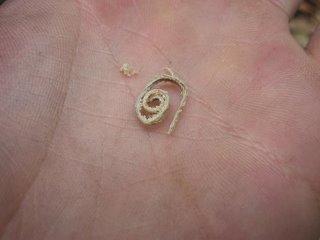Thursday, August 24, 2006
Wood sawyer
I like to rip- and cross- cut wood myself, and by hand. It probably dates back from my childhood when I saw a TV program showing an attachement for a chainsaw, allowing anyone at home to easily produce his/her own planks. That was really interesting.
Years later (maybe 20), I see for the first time a maebiki, the bell ringed in my head. That big saw was used by Japanese to rip cut trunks. I had to get one. It was not easy, but here was I, with my first maebiki. An impressive tool. It is an old one, but I have been able to use it. Since then I have also get other smaller saws and spend sometimes hours sawing the wood I gather myself (eucalyptus, pine, orange tree...).

Maebiki saw. Ripping a log of pine. With that setting, the log is stable on each pull stroke.

An example of rip cut.
 A shaving, produced by a rip saw. An excellent illustration showing that each teeth of the ripsaw act as a little chisel.
A shaving, produced by a rip saw. An excellent illustration showing that each teeth of the ripsaw act as a little chisel.
Years later (maybe 20), I see for the first time a maebiki, the bell ringed in my head. That big saw was used by Japanese to rip cut trunks. I had to get one. It was not easy, but here was I, with my first maebiki. An impressive tool. It is an old one, but I have been able to use it. Since then I have also get other smaller saws and spend sometimes hours sawing the wood I gather myself (eucalyptus, pine, orange tree...).

Maebiki saw. Ripping a log of pine. With that setting, the log is stable on each pull stroke.

An example of rip cut.
 A shaving, produced by a rip saw. An excellent illustration showing that each teeth of the ripsaw act as a little chisel.
A shaving, produced by a rip saw. An excellent illustration showing that each teeth of the ripsaw act as a little chisel.